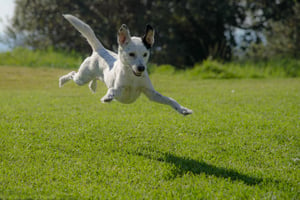Dogs chewing hair off their tail is a common problem for pet owners. Not only is it distressing for...
What to Do When Your Dog Chews Off Their Own Tail
If your dog has chewed off its own tail, it can be a traumatic experience for both the pet and their owner. It is important to take appropriate action to ensure the health and safety of your dog. This article will provide an overview of the most common causes of tail chewing, the immediate steps to take, and what to do in the long run.
Common Causes of Tail Chewing
Tail chewing is a relatively common problem in dogs, particularly in breeds that have long fur or a thick coat. Some of the most common causes of tail chewing include:
- Allergies: Allergies can cause a dog to scratch or chew at their tail to relieve the itchiness.
- Pain or Discomfort: If the dog has an injury or soreness in the area, they may chew their tail as a way to relieve the pain.
- Boredom or Anxiety: Dogs may chew their tail out of boredom or as a way to reduce their anxiety.
It is important to take note of the underlying cause of the tail chewing in order to prevent it from happening again in the future.
Immediate Steps to Take
The first step you should take if your dog has chewed off its own tail is to seek veterinary care. If the tail has been completely chewed off, the vet may be able to reattach it. However, if the tail has been severely damaged, the vet may recommend amputation. In any case, the vet will be able to provide advice on how to prevent further injury to your dog.
It is also important to take measures to prevent your dog from further injuring itself. If the tail chewing is caused by boredom or anxiety, you can provide your dog with plenty of mental stimulation and exercise. If the tail chewing is caused by allergies, you can consult your vet to identify the trigger and find ways to reduce the dog's exposure to it.
Long-Term Prevention
The best way to prevent your dog from chewing its own tail is to address the underlying cause. If the tail chewing is caused by boredom or anxiety, you should provide your dog with plenty of mental stimulation and exercise. If the tail chewing is caused by allergies, you should consult your vet to identify the trigger and find ways to reduce the dog's exposure to it.
It is also important to take measures to make sure that your dog is not able to access its tail. For example, if your dog is a long-haired breed, you should keep the fur trimmed short to reduce the risk of tail chewing. Additionally, you should keep your dog in a secure area where it cannot access its tail.
Conclusion
If your dog has chewed off its own tail, it is important to take immediate action to ensure the health and safety of your pet. You should seek veterinary care and take measures to prevent your dog from further injuring itself. Additionally, you should address the underlying cause of the tail chewing in order to prevent it from happening again in the future. By following these steps, you can ensure that your dog stays safe and healthy.



